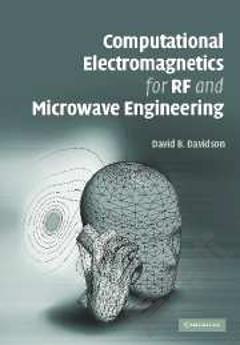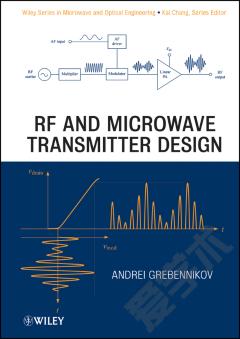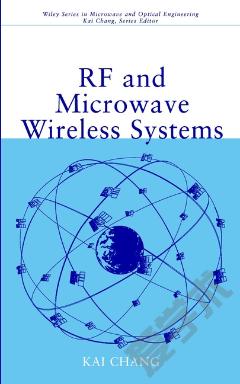Microwave and RF Engineering
About the Authors. Preface. 1 Introduction. 1.1 Microwaves and radio frequencies. 1.2 Frequency bands. 1.3 Applications. Bibliography. 2 Basic electromagnetic theory. 2.1 Introduction. 2.2 Maxwell's equations. 2.3 Time-harmonic EM fields polarization of a vector. 2.4 Maxwell's equations in the harmonic regime. 2.5 Boundary conditions. 2.6 Energy and power of the EM field Poynting's theorem. 2.7 Some fundamental theorems. 2.8 Plane waves. 2.9 Solution of the wave equation in rectangularcoordinates. 2.10 Reflection and transmission of plane waves Snel'slaws. 2.11 Electrodynamic potentials. Bibliography. 3 Guided EM propagation. 3.1 Introduction. 3.2 Cylindrical structures solution of Maxwell sequations as TE, TM and TEM modes. 3.3 Modes of propagation as transmission lines. 3.4 Transmission lines as 1-D circuits. 3.5 Phase velocity, group velocity and energy velocity. 3.6 Properties of the transverse modal vectors et, ht fieldexpansion in a waveguide. 3.7 Loss, attenuation and power handling in real waveguides. 3.8 The rectangular waveguide. 3.9 The ridge waveguide. 3.10 The circular waveguide. 3.11 The coaxial cable. 3.12 The parallel-plate waveguide. 3.13 The stripline. 3.14 The microstrip line. 3.15 The coplanar waveguide. 3.16 Coupled lines. Bibliography. 4 Microwave circuits. 4.1 Introduction. 4.2 Microwave circuit formulation. 4.3 Terminated transmission lines. 4.4 The Smith chart. 4.5 Power flow. 4.6 Matrix representations. 4.7 Circuit model of a transmission line section. 4.8 Shifting the reference planes. 4.9 Loaded two-port network. 4.10 Matrix description of coupled lines. 4.11 Matching of coupled lines. 4.12 Two-port networks using coupled-line sections. Bibliography. 5 Resonators and cavities. 5.1 Introduction. 5.2 The resonant condition. 5.3 Quality factor or Q. 5.4 Transmission line resonators. 5.5 Planar resonators. 5.6 Cavity resonators. 5.7 Computation of the Q factor of a cavity resonator. 5.8 Dielectric resonators. 5.9 Expansion of EM fields. Bibliography. 6 Impedance matching. 6.1 Introduction. 6.2 Fano's bound. 6.3 Quarter-wavelength transformer. 6.4 Multi-section quarter-wavelength transformers. 6.5 Line and stub transformers stub tuners. 6.6 Lumped L networks. 7 Passive microwave components. 7.1 Introduction. 7.2 Matched loads. 7.3 Movable short circuit. 7.4 Attenuators. 7.5 Fixed phase shifters. 7.6 Junctions and interconnections. 7.7 Dividers and combiners. 7.8 Lumped element realizations. 7.9 Multi-beam forming networks. 7.10 Non-reciprocal components. Bibliography. 8 Microwave filters. 8.1 Introduction. 8.2 Definitions. 8.3 Lowdpass prototype. 8.4 Semi-lumped lowdpass filters. 8.5 Frequency transformations. 8.6 Kuroda identities. 8.7 Immittance inverters. Bibliography. 9 Basic concepts for microwave component design. 9.1 Introduction. 9.2 Cascaded linear two-port networks.9 9.3 Signal flow graphs. 9.4 Noise in two-port networks. 9.5 Nonlinear two-port networks. 9.6 Semiconductors devices. 9.7 Electrical models of high-frequency semiconductordevices. Bibliography. 10 Microwave control components. 10.1 Introduction. 10.2 Switches. 10.3 Variable attenuators. 10.4 Phase shifters. Bibliography. 11 Amplifiers. 11.1 Introduction. 11.2 Small-signal amplifiers. 11.3 Low-noise amplifiers. 11.4 Design of trial amplifier. 11.5 Power amplifiers. 11.6 Other amplifier configurations. 11.7 Some examples of microwave amplifiers. Bibliography. 12 Oscillators. 12.1 Introduction. 12.2 General principles. 12.3 Negative resistance oscillators. 12.4 Positive feedback oscillators. 12.5 Standard oscillator configuration. 12.6 Design of a trial oscillator. 12.7 Oscillator specifications. 12.8 Special oscillators. 12.9 Design of a push-push microwave VCO. Bibliography. 13 Frequency converters. 13.1 Introduction. 13.2 Detectors. 13.3 Mixers. 13.4 Frequency multipliers. Bibliography. 14 Microwave circuit technology. 14.1 Introduction. 14.2 Hybrid and monolithic integrated circuits. 14.3 Basic MMIC elements. 14.4 Simulation models and layout libraries. 14.5 MMIC production technique. 14.6 RFIC. 15 RF and microwave architectures. 15.1 Introduction. 15.2 Review of modulation theory. 15.3 Transmitters. 15.4 Receivers. 15.5 Further concepts on RF transmitters and receivers. 15.6 Special radio functional blocks. 16 Numerical methods and CAD. 16.1 Introduction. 16.2 EM analysis. 16.3 Circuit analysis. 16.4 Optimization. 17 Measurement instrumentation and techniques. 17.1 Introduction. 17.2 Power meters. 17.3 Frequency meters. 17.4 Spectrum analyzers. 17.5 Wide-band sampling oscilloscopes. 17.6 Network analyzers. 17.7 Special test instruments. Appendix A Useful relations from vector analysis andtrigonometric function identities. Appendix B Fourier transform. Appendix C Orthogonality of the eigenvectors in idealwaveguides. Appendix D Standard rectangular waveguides and coaxialcables. Appendix E Symbols for electric diagrams. Appendix F List of acronyms. Index.
{{comment.content}}








 京公网安备 11010802027623号
京公网安备 11010802027623号